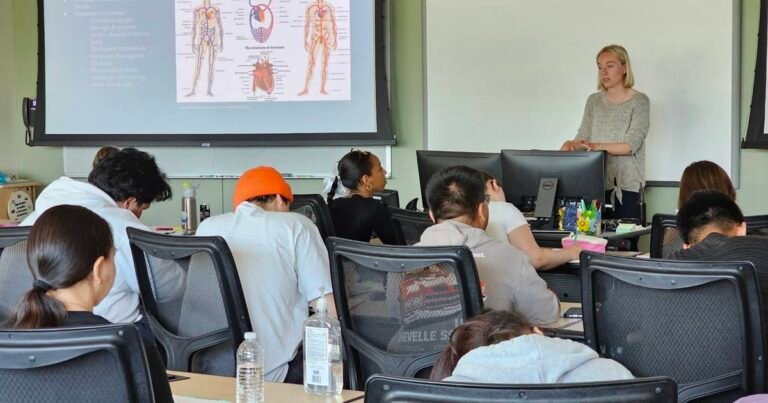:quality(70)/cloudfront-us-east-1.images.arcpublishing.com/adn/WAXSSHNAB5CHTBBKI5JIQET6YU.jpg)
Of all the courses offered by Della Keats’ college prep program, the one that impressed the three high school students in the lobby of the University of Alaska Anchorage most was the cadaver lab in the anatomy and physiology course. This is not the kind of opportunity students in rural Alaska typically get, but that’s the point.
Bristol Albrandt, 16, from Ketchikan, said the experience was hard to put into words. “It’s definitely not normal. Not many people are blessed with a donor like that,” she said.
For Napakiak native Tanya Nelson, it was her first time seeing a dead body. “Probably the first time for most of us,” she said with a smile.
Albrandt wants to go to medical school, Nelson is interested in nursing, and Krus Kváznikov, 18, of Nanwalek, wants to be a paramedic because his father works in the medical field.
All three are in Anchorage for a month as part of a program aimed at promoting early college success among Native and otherwise underrepresented students in rural Alaska who are interested in health-related careers. The program is named after Della Keats, a traditional healer of the Inupiaq people of Noatak Country.
The Della Keats program was on hiatus for six years due to a lack of funding, but it was revived for the first time since 2018. Halfway through the program, organizers learned the effort had secured a $1.3 million grant from the Indian Health Service, allowing it to continue operating for at least another five years.
The program aims to address health equity gaps. Data shows that Alaska Natives and American Indians are underrepresented in health care careers, both in Alaska and nationally. The program focuses on students considering careers in research, medicine, or allied health professions, ensuring Alaskans have the benefit of a more diverse health care workforce. The Della Keats reboot is released as the state grapples with a severe nursing shortage in the wake of the pandemic.
Gloria Barnett, director of UAA’s Alaska Rural Health and Medical Workforce Center, said the news is a relief after several previous grant applications were unsuccessful. She said it eases the burden of resolving financial issues and allows administrators to focus on building the program.
“Many of our students don’t have these opportunities in their hometowns, so it’s definitely a culture shock when they leave their small hometown and come to a big place like college,” Barnett says. “Our goal is to make college a more welcoming place and space for them when they’re in high school, and make life easier for them after they graduate.”
Barnett said the new funding will add new elements to Della Keats, including outreach to students in kindergarten through eighth grade and the creation of an Alaska Native learning community for undergraduates in the University of Washington’s Multistate Medical Education Program (known as WWAMI, an acronym for the participating states Washington, Wyoming, Alaska, Montana and Idaho), which has staff and courses on the UAA campus.
“It’s important to get kids interested, and I think Alaska does a really good job of that, but it’s not necessarily a bridge to higher education,” she says. Della Keats fills that gap by showing students what the training programs are like, what the requirements are, and introducing them to the paperwork and financial aid, she says. It also teaches them how to live independently. Students live in dorms and receive a stipend that they must budget for daily lunches, weekend activities, and more.
Students like Albrandt, Nelson and Kvazhnikov experience college-style coursework and independent residential living with the support of mentors who are now in the medical school after completing the program.
Program graduate Chanmi Joo, who just completed her first year at the University of Washington School of Medicine, has attended Della Keats twice and this is her fourth year serving as a mentor.
“The cadaver lab was also my favorite. Not only did it solidify my desire to go into medicine, but I think it also made me realize that this is how you can make an impact — not just on your patients, but on future generations,” she said.
Ju said the program helped her decide which area of medicine was right for her and started her on her path to becoming a surgeon, something she hopes to be a part of for the next generation of medical professionals.
Nelson is interested in returning to western Alaska to work as a nurse in the central city of Bethel, but she said the program also helped her determine which areas of medicine weren’t for her. “I’m not interested in research,” she said. “I like seeing patients.”
“Yes, practice,” Kvazhnikov added.
Albrandt agreed: “I don’t like being in the lab. I prefer to figure out problems and solve them.”
She also said she hopes to return to Alaska after graduating from medical school: “I may want to move around a lot for school,” she said, “but I definitely want to come back to Ketchikan afterwards and give back as much as I can.”
Originally Alaska BeaconAn independent, nonpartisan news organization covering Alaska state government.


